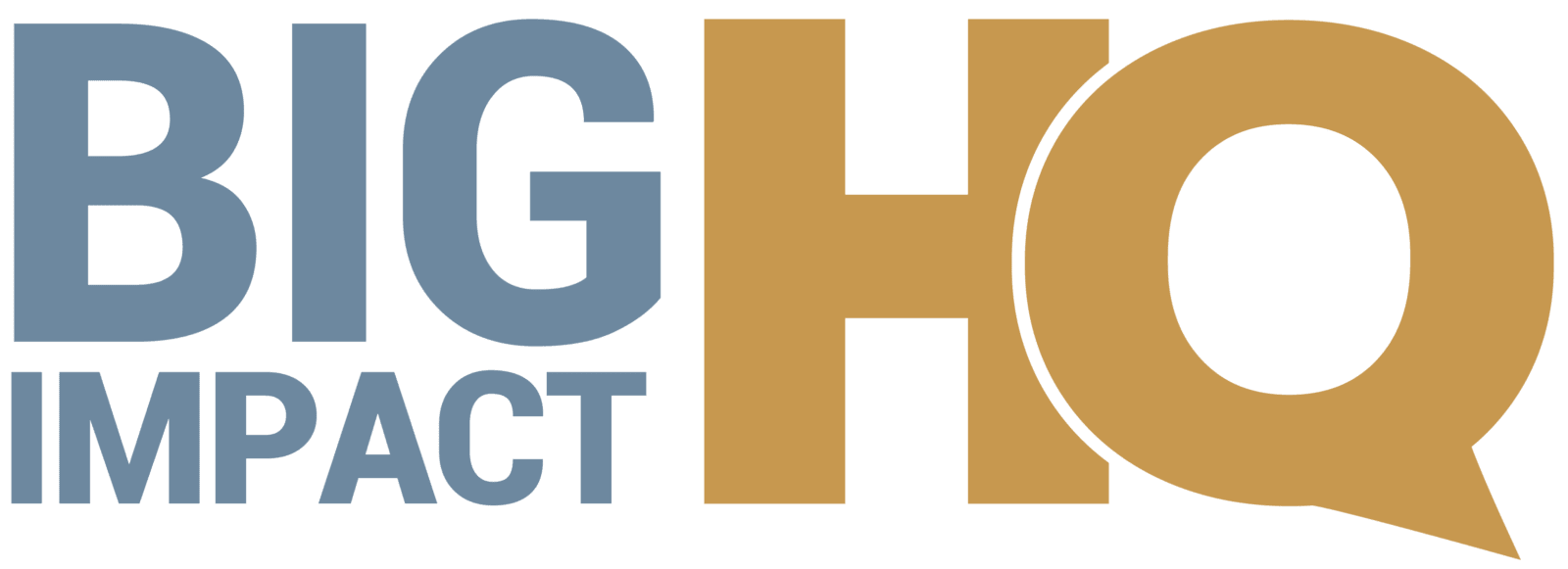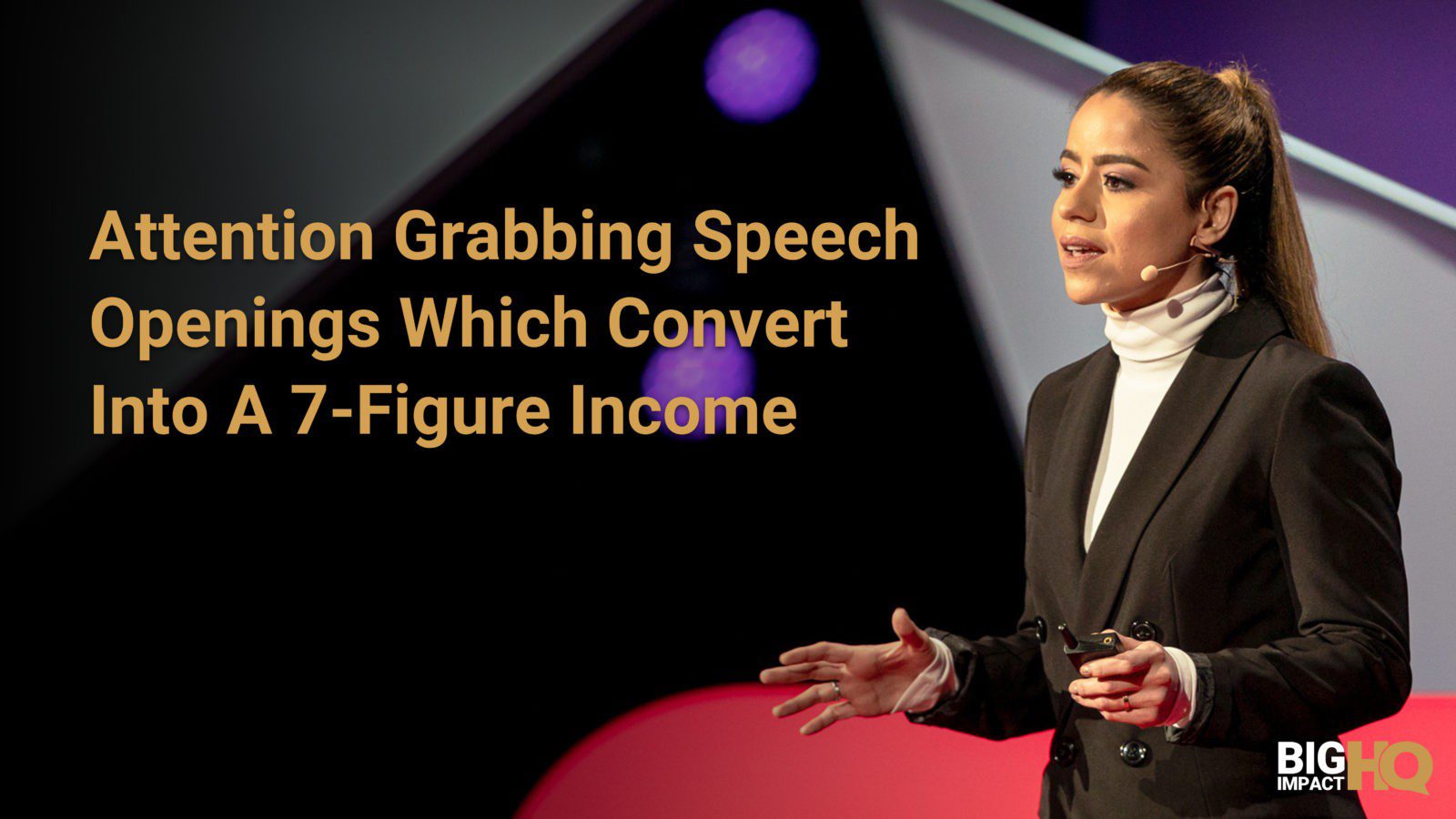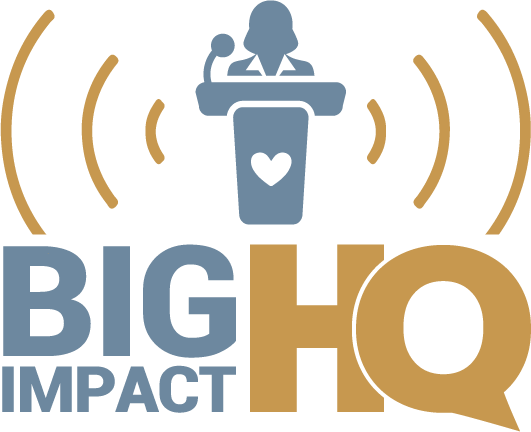Speech openers can help you grab your audience’s attention with impact and set the tone of your presentation. You should know how to take the stage properly in order to maximize your chance of success. This can have a major effect on your income so they’re more likely to become customers or clients.
In this small guide, we’ll explain everything about hot speech opening lines so you can create great ones for your future speeches that can eventually convert into a 7-figure income.
What is a Speech
A speech is intended to educate, persuade or motivate an audience. It can range from business presentations, keynotes, and political addresses to ceremonial ones. Generally, its main objective is to communicate information in an engaging way with the goal of sparking positive action and change.
When orchestrated well, it will not only capture an audience’s eyes and ears, or inspire and enlighten them with moving words, but it also unites people from all walks of life in ways we could never imagine by addressing shared concerns and ideas that appeal to us on a deep emotional level.
Basic Structure of A Speech
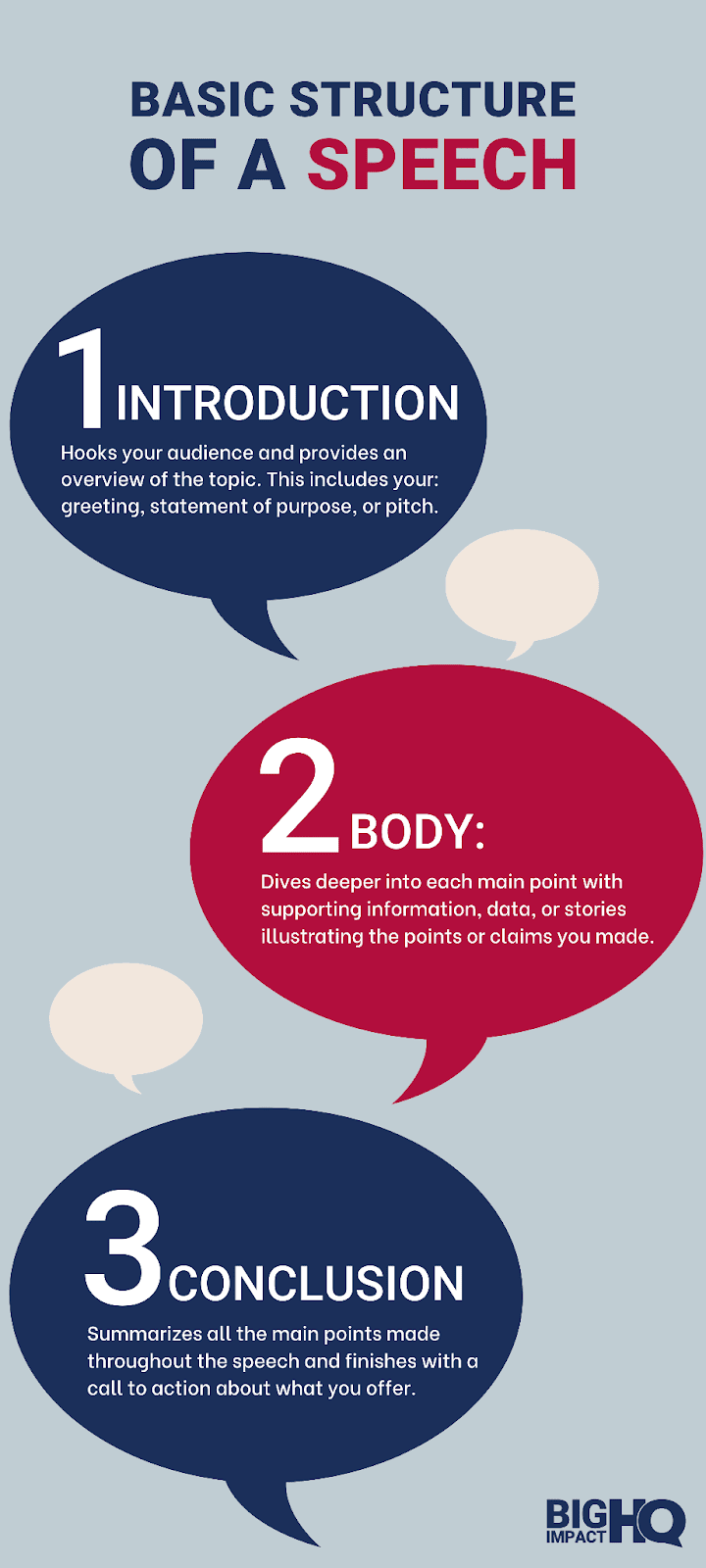
Having the right structure of a speech is essential to its success. It should be organized in such a way that it provides clarity and flow, ensuring the listener understands and remembers the main points.
When crafting a speech, it’s important to consider your message, audience, and delivery to ensure more than surface level effectiveness – all integral components in constructing a captivating experience.
If you want a more detailed structure of what to include in your Signature Speech or Talk, you can find it here.
The basic structure of a speech is quite simple and consists of three main elements:
INTRODUCTION:
Hooks your audience and provides an overview of the topic. This includes your: greeting, statement of purpose or pitch.
BODY:
Dive deeper into each main point with supporting information, data, or stories illustrating the points or claims you made.
CONCLUSION
Summarizes all the main points made throughout the speech and finishes with a call to action about what you offer.
Speech Openings that Grab Attention
No matter what the occasion, what virtual or live stage you are on, your opening line is essential for setting the tone of your presentation. If you want to be successful in a public speaking situation, it’s vital that you know how to make an impactful start.
Next, we’ll show you exactly what unbeatable speech openers you can use when it’s time for you to stand up and speak again – so people will give you the recognition you deserve as a master orator!
What is a good opening for a speech?
To catch and maintain your audience engagement, select an opener that resonates with both you and your presentation topic. Think outside the box – get creative and find something original enough to capture everyone’s attention right off the bat.
You can start your speech with
- Powerful statements. As a speaker, you know how it can be very effective, but you need to pick something as strong as a double-edged sword, relevant enough to help you prove a point later in the speech but also pierces into their soul. And stay away from cliche quotes (more on that later).
- Question. If you begin your speech with a question, you’ll immediately engage the audience members. They’ll start thinking about possible answers, so they’ll follow your presentation carefully to get a reply. Naturally, you should ask captivating questions rather than simple ones with an obvious reply. Connect the opening question with the central idea of your speech so you can set the theme and the tone for the main thing that follows.
- Story. To captivate the audience, some public speakers like Oprah and Lisa Nichols open their speeches with a story. By using the power storytelling, you’ll be able to connect with the crowd. You can also tell a news story, but make sure to offer your personal perspective and a unique view of the topic. You don’t need precise details to tell a story. Just start with “Years ago…”, “I used to…”, and other vague statements.
- Statistical data. In order to start a speech with statistical information, you need to anticipate the reception. Many people from the audience aren’t huge fans of numbers and stats, so they might yawn once you start throwing numbers at them. That’s why it’s best you offer one or two crucial numbers that prove your point. Take a look at Jamie Oliver and his TED talk about food. He had a great opening with frightening statistical data so people could realize the importance of a nutritious diet and listen up.
- Silence. Another great way to start your speech can be a long pause. You should avoid the usual greetings such as “Good morning” or “Hello” and just hold on for a moment. Make a strong, confident stance, and look at your audience for 4-5 seconds. They’ll be on the edge of their seats, keeping their eyes and ears on you, waiting for you to say the opening line. But instead, you’ll just carry on as nothing has happened.
- First Mental Image. “You’re hauling ass down a busy highway when you see a police officer’s lights flashing in your rear view mirror.” A first mental image is a wonderful way to captivate your audience as it places them right in the center of a story… as if they’re looking through their own eyes. Keep this brief and find a way to tie your FMI into the topic of your speech.
The tone of the speech is also set by the introduction. A great speech opening can be:
- Creative – the “imagine” and “what if” scenarios. For example, Ric Elias started his TED Talk with a story about his plane crash experience. He wanted to amplify the importance of the lessons he learned from this experience, so he had people imagine what it would be like going through that. Attention to detail is very important when you’re using this tactic because you want to spark the imagination of the crowd.
- Humorous. You can start your speech with a joke or a funny statement like what Ellen DeGeneres usually does, but only if you’re comfortable with using humor. If jokes come to you naturally, use them. If not, it’s better to steer away from a humorous introduction because it might seem forced and fake. And, of course, be sure your audience doesn’t see the joke as offensive. You can try it out on a group of people from your close surroundings to check the reception.
- Serious. You should use serious opening lines when you want to position yourself as an authority on the subject. Experts are confident in their knowledge, and their body language shows it. That’s why your ideas, if presented seriously, can have a bigger influence on the audience.
Note that you should practice combining these approaches. For example, silence should follow a serious powerful statement or statistical data could be presented humorously. A world-class speaker combines everything she can to get her audience interested!
How do you start a speech opening?
When it comes to making a memorable first impression on stage, how you do it in the first 4-6 seconds is key! There are various ways to start a speech. Which one you’ll choose depends on your preferences, target market, the type of presentation you’re doing, and the ideas you want to share.
We’ve given you great examples of opening speeches but how do you start?
Precision and Clarity
Every speaker needs to have a clear message, preferably only one big idea. Having more might confuse the audience and your speech won’t be successful. Once you clarify your main point, you’ll have no problems expressing it to others.
Always use simple language and stay away from business jargon. You don’t “sound smart” with complex word structures; you just confuse the listeners. And a confused audience means lost buyers or bye bye sales. A person that can explain complex things with simple words is the one worthy of listening to, and people know it!
Be precise when describing something. Don’t force people to think too much when trying to figure out any abstract metaphors. In the worst case, you’ll get misunderstood, and in the best case, they’ll ignore you. Being concrete and precise will help you avoid miscommunication so the audience can understand you perfectly.
Make sure to also clearly state the next action you want people to take. What can they use from your speech that can change their lives? People want to be inspired, and great speakers know how to do this.

Start with Confidence
We previously stated that confidence is important for public speaking. You must start your speech confidently and impress people. The usual “Erm… I’m honored to be here… thanks very much for inviting me…” doesn’t make a great impression. Preparing and practicing will keep you on the right course. It will also help you be relaxed and calm.
You’ll either wow the audience or lose them with the opening line you choose. That’s a lot of pressure! Luckily for you, confidence can be learned. Try this simple method: record yourself at home and watch. Write down things you liked about your stance and focus on them in the future. Confidence means embracing your good qualities with pride.
Just remember: confidence and arrogance aren’t the same. People are perceived as arrogant when they’re completely focused on themselves. You’re there to give a speech to your audience members to make it about them, not so much about you.

Million Dollar Speech Structure
To get many people to carefully listen, framing the speech is so important. Your speech needs a structure, but it doesn’t have to be a strict one. You don’t want to seem and sound robotic, nor should you read something on stage. You need to talk naturally. Just watch a couple of great speeches on BigImpactHQ’s Website or Newsletters, TED talk, and other platforms. You could also tune in to political speeches – maybe even hear the president talking. The one thing these great speakers all have in common is natural flow!
A speech opening needs to be in direct relation with the rest of the talk. If you come speaking about something random and then shift your focus on a completely different subject, people will lose interest and start ignoring every word you say.
One more thing: speeches need a bit of drama. The opening line can present a problem which you’ll resolve as you’re finishing the speech. Delivering the solution will amplify the message you had for the listeners.
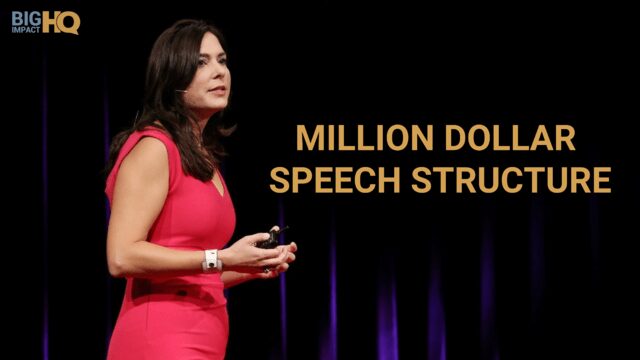
Invite Friends to Hear Your Speech
As an experienced woman speaker, there are still times where you feel the jitters just by thinking about giving a speech in front of strangers, you’re not alone. Don’t hesitate to invite some familiar people to hear you talk when the big day comes. You can ask your friend, mom, dad, or even your grandparents for support. Seeing a friendly face in the crowd will boost your confidence to deliver an amazing opening line and make a great first impression.
Use Props and Videos
Mohammed Qahtani did a cigarette stunt so people heard his point more clearly because he used a unique prop. Using props, videos, and other additional materials to start a speech should be a judgment call. Sometimes this can really work because it reverses the audience’s expectations. They just expect a speaker and nothing else. If you do more than talking, you’ll immediately get noticed, and people will listen to you more carefully.


What You Should NOT Do
There are certain opening lines that you should avoid at all costs. Getting off on the wrong foot can set your presentation up for failure – so be sure to steer away from these opening lines:
Start with a quote
There’s nothing wrong with quotes in the general sense, but everyone is already relying on repetitive and unoriginal quotes and you don’t want to be “everyone”. Average speakers just choose a popular quote and hope it’s inspiring enough. Unfortunately, these quotes are often blunt and overused, so it’s best you avoid them entirely. Get creative and choose something that is truly empowering!
Hesitate
When you’re up on the stage, and your opening line is “Okay… hm.. I just want to…”, you won’t make a good impression. You’ll seem like an insecure person that doesn’t know what to do, nor what to say. Your entire speech can sink with a thing like this! If you don’t have THE opening line, just start your speech directly. Pause for 10 seconds and get straight to the point. It’s way better than rambling and delaying the start.
Using the word, “SO”
This word is not just too casual, but it also provides a very weak speech opening. You need to come out as strong and bold to get the audience interested, and “so” isn’t helping you do that.
Start with, “My name is…”
People should already know who you are if you’re properly introduced by the organizers. Repeating your name is redundant, and it takes away your opportunity to deliver a great opening line.
Waste time on greetings and thanks
Instead of wasting time on lengthy greetings and thank yous for the audience and the organizers at the start, make sure to save your appreciation for when it really counts – in the closing remarks.
CONCLUSION
A hot speech opening which grabs the attention of your audience will spark interest, showcase valuable data and move them into eager fans who want to work with you. You now hold the secret weapon to make this happen that average speakers don’t know about.
The power of a great speech is undeniable. With a few words, the speaker can inspire, motivate and even change perspectives. It’s no surprise that the impact of such speeches can last much longer than the allotted time given to the speaker. Whether it was delivered in front of an audience or recorded for later viewing, its effect would remain long after it was initially heard.
One thing great speakers all have in common? They immediately apply what they learn. Since you’ve read up to here, it shows how serious you are about having that 7 figure income stream soon!

